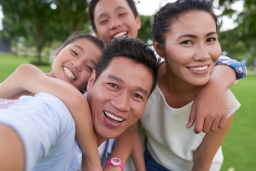Inclusion requires action! Creating inclusion for newcomers to Canada
Wednesday, October 24, 2018 - 09:00

It is clear that the next generation will be diverse, multicultural and, apparently, much less fit than the previous generations. Research points in this general direction, but results from the recent TOPO survey, released in May 2018, demonstrates this trend clearly. The 2017 survey engaged 13,400 children and 7,800 parents across all school boards on the Island of Montreal to explore lifestyle habits, physical and emotional health, school life, bullying, family life and educational success.
The TOPO survey reveals the significance of immigration amongst families with school aged children - 23% of Grade 6 students were born outside the country, of which 41% have been living in Canada for five years or less; and 59% of all students have one or both parents born outside of Canada. Evidence shows that change is happening in many major Canadian cities.
Survey results also show that 65% of grade 6 students are failing to meet the recommendations for physical activity (60 minutes per day) - sadly consistent with the national average reported in the 2018 ParticipACTION Report Card. However, the TOPO survey also shows that the proportion of young people who do not meet the physical activity recommendations fluctuates significantly between the highly affluent neighbourhoods (58%) and lower-income neighbourhoods (69%), but even more so for those areas where there is a significant number of immigrant families and where physical inactivity rates go as high as 72%.
Although survey results were specific to Montreal, findings seem typical of situations in other large Canadian cities. Combining survey results directly with data on immigration could provide some insightful findings.
Applying the findings to the Canadian sport system, it is clear that the significant number of newcomers to Canada will have an impact – not only for traditionally popular sports for which the demand and participation could decrease, but also across the range of services offered by sport, recreation and cultural organizations.
Changing demographics will present recruitment challenges for many sport organizations. Young people who are newcomers to Canada seem less inclined to want to play structured sport or discover new activities, especially activities that are unfamiliar to them or their families, seem contrary to their values or cultural beliefs and practices, or in which they simply feel excluded for various reasons. Combine these personal barriers with organizational barriers, such as exclusive policies and practices or lack of access to services and support in the first language of newcomers, and the reasons for low participation rates become clearer.
Taking Action
We must act quickly and in many ways.
Schools and community sport and recreation organizations must invest in developing fundamental movement skills and physical literacy amongst all children and youth, developing their motivation and confidence to try new activities and choose to be active for life.
The “Sport for Life for all Newcomers to Canada” resource identifies key barriers with action-oriented solutions, opportunities and promising practices to include these young people and their families in the world of sport and physical activity.
Fundamental to success is better understanding the situation. Organizations must “do their homework” and develop new strategies:
- Understand the unique challenges for newcomers to participate in your sport. Consider cost, location, equipment, knowledge/awareness, skills, cultural issues, etc.
- Understand and become educated about newcomers’ countries of origin, the barriers they face to settling in Canada, and their needs for sport and physical activity.
- Connect with various stakeholders (e.g. national sport organizations, provincial/territorial sport organizations, local clubs and recreation centres, settlement and other support organizations) to discuss ideas and work together to achieve common goal of inclusion.
- Prioritize organizational solutions that can be implemented quickly.
Based on enhanced understanding, organizations must then take action to develop relationships, facilitate engagement, and ultimately increase participation:
- Create an advisory committee of community members and newcomers to help guide action.
- Organize annual and bi-annual events that allow newcomers to try your sport or activity. Team-up with various organizations so participants can try different sports.
- Seek ways to offer low cost or free activities.
- Identify "champions" who can act as spokespersons of different sports within the target communities.
Engaging newcomers presents an amazing opportunity for the Canadian sport system, but one that will require time and effort. The Sport for Life resource provides concrete solutions to common problems, and also profiles successful programs from Montreal and other major Canadian cities. Connect, learn and take action.
About the author
Pierre Morin has been working for the last 45 years to make the benefits of recreation, sports and physical activity accessible to everybody - most recently as CEO of Réseau Accès Participation and formerly as a municipal recreation director.